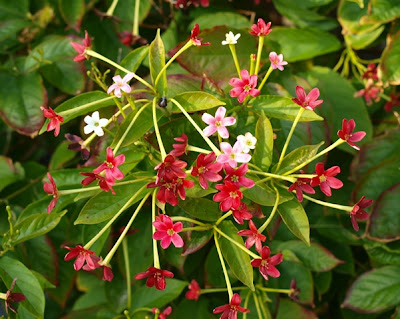In what way is Quisqualis who and which?
Rangoon Creeper is evocative enough as a name but the botanical name for this plant is even more intriguing - Quisqualis indica. The last bit is fairly straight forward, although the species grows throughout the tropics and not just in India.
As for Quisqualis, this is Latin for something like 'any such', 'what way is it now', 'in which way' or perhaps 'Who and what?'. It's one of those words that means je ne sais quoi.
But why would a plant be given such a name? It seems that the author, Georg Eberhard Rumphius, a seventeenth century Dutch East Indies Trading Company merchant and man of good humour, was punning on the local name for the plant, Undani, which sounds a bit like the Dutch word hoedanig, which means something like quis qualis...
All this had a deeper meaning for Rumphius who found it sometimes looking like a shrub or a tree, but then next time a vine. Sometimes the stem was thorny and other times smooth. Like the God Proteus, he said, it takes many forms. His pet name Quis qualis must have appealed to the Swedish botanists Carl Linnaeus who described the genus a half century or so later as Quisqualis.
This charming and charmingly named plant grows luxuriously around one of the pillars near The Terrace cafe in Royal Botanic Gardens Melbourne. It can be invasive in more tropical climes, such as southern USA and northern Australia, but I haven't seen any reports of it becoming naturalised in southern Australia.
Other people obviously like the name 'quisqualis' as much as me. There is a website devoted to rare plants carrying this name, which also has a go at explaining why the Rangoon Creeper is called Quisqualis.
Their version has different plant hunters finding different forms of the plant (shrub, creeper, thorny...) and sending them back to home to the confusion of the experts who only get to see fragments of the full story. This site also mentions the change in colour from white to red as the flower ages, one of the appealing aspects of this bush/creeper in horticulture.
The perfume of the flower - 'fruity' or toasted coconut - is as exotic and attractive as its names.
If you want to experience the full splendour of the Rangoon Creeper plant you should use a trellis, pergola or column so that it can do it's thing, whatever that is, with some support.
Note: Quisqualis is sometimes included within a more broadly circumscribed Combretum but I followed a 2011 paper that recommends sticking with Quisqualis for our species. However these kind of taxonomic judgments are not always straight forward and Royal Botanic Gardens Melbourne has decided to use Combretum for now. Horticultural botanists Roger Spencer and Rob Cross provided the following background. "The
name Quisqualis indica is used, among others, by the Flora of China, Papua New Guinea Checklist, the Queensland checklist and the European Garden Flora (second edition). The name Combretum indicum was adopted in the Gardens Census in 2000 as a result of a series of papers by Jongkind (1991, 1992, 1999). It is also followed by English botanist Stace in a well-respected synoptic work edited by Kubitsky (2007), also in Mabberley (2008) and following a discussion of characters by Tilney (2002). There is clearly a divergence of views on the appropriate genus name for this species.
The paper by Jordaan et al (Bothalia 41(1): 161-169 Generic status of Quisqualis... has been read and noted. It is our view that there is still taxonomic work to be done to warrant the use of the genus name Quisqualis and that we may indeed change back to Quisqualis when this is published. Even Jordaan et al. note that the taxonomic work is not complete. In the meantime we think Combretum is the most appropriate name to use in the Census." Of course I'm sticking with Quisqualis because it makes for a good blog post!



Comments
cheers, Gareth.
Tim
(I've added a reference to this paper at end!)
cheers, Gareth